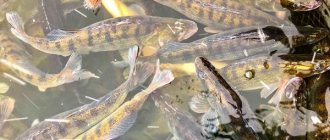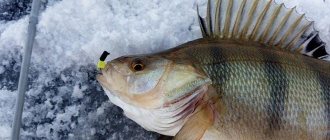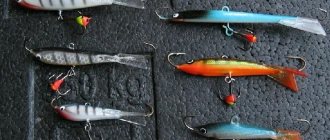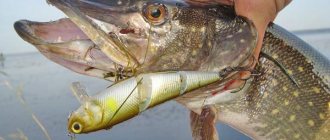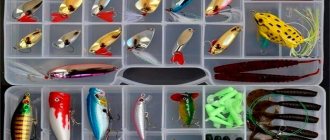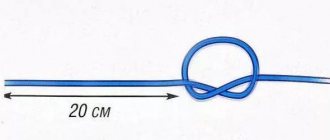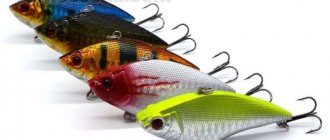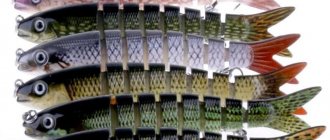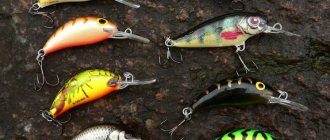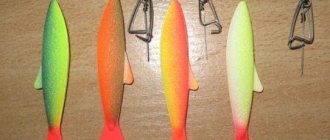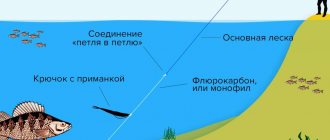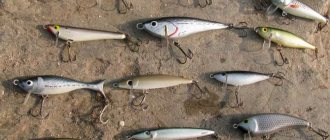And only after some time, when, approximately in the late 90s, a wave of twitching reached us, it became clear that actively animated wobblers turn out to be more effective. Then many “rejected” baits received a second chance.
Uniform wiring
Uniform wiring is effective when catching chub and asp
Over time, it became clear that uniform wiring is by no means basic, but one of the many options for feeding a wobbler. Now, from the standpoint of modern knowledge, it is incorrect to say that uniform wiring is much inferior in effectiveness. This is due to the fact that not all fish react positively to the jerky movements of the wobbler. In particular, these are the chub and asp. It is for these fish that monotonous uniform wiring is the main one. The circumstances where it will be most effective are strong currents and high water temperatures. That is, exactly the conditions that white predators like.
Basics of twitching wiring
The basic movement of the twitching fishing technique is considered to be jerking with the rod. Moreover, jerks can be done long, short and medium. You can perform them slowly and quickly, with short or long pauses. By combining different lengths of jerks and stops between them, you can greatly diversify your fishing.
After performing a jerk and returning the rod to its original position, it is recommended to rewind the previously weakened reel line. This will eliminate the possibility of premature wear of the reel seat mechanism, placing a small load on it. Because there are models of wobblers that are distinguished by significant tenacity. They will definitely harm the coil. Moreover, synchronous rewinding will prevent loops of fishing line from accidentally coming off the spool, forming “beards”. After completing each jerk, it is recommended to repeat the entire cycle.
Twitching and jerking
Minnow wobblers - a classic for twitching wiring
The term “jerkbait” in Europe was initially understood in a narrow sense: impressive wooden blanks designed for catching pike with powerful casting gear using jerk fishing. Since the word “jerk” in translation means jerk.
But in any language, synonyms are used to denote one or another term. And if you are not a native speaker, it is extremely difficult to grasp the nuances. For our case, a synonym for the term “jerking” is “twitching”.
At a first approximation, the difference is not particularly noticeable. What is even more misleading is that in the pages of American periodicals these two words regularly appear together and alternately. And on the packaging of jerk wobblers there may be the inscription both twitchbait and jerkbait. But if you carefully read the text or watch the video regarding jerk wiring, the nuances will begin to emerge.
Twitching is characterized by a calmer and softer animation style with a smaller range of movements. This is why the word “twitching” is used extremely rarely when describing the wiring of large jerkbaits – only “jercking”. The common point of both techniques is that the rod moves in a horizontal (or near) plane.
The main baits for these techniques are classic minnow wobblers and sluggish shad.
Methods for wiring wobblers
All spinning anglers learned to use the tackle, starting with evenly retrieving the bait. This is due to the ease of bait placement, as well as the lack of any spinning fishing skills. First you need to learn how to make long but accurate casts and only then proceed to more complex castings. Moreover, such a bait as a wobbler has its own game and very often a predator attacks it when using a straight line. But this happens mainly when the predator is active.
If he is passive, then he must be forced to make an attack. With the advent of new wiring techniques, even those baits that had been collecting dust for a long time in the arsenal of fishermen began to work.
Ripping
Sluggish Shads, like Minnows, are good for ripping
At first glance, ripping seems to be another synonym for twitching and jerking, since it is also a method of jerking a wobbler. But in practice, this technique has more in common with the main meaning: the verb “to rip” is translated as “gutting” or “ripping.”
In this case, the movements of the rod are made in a vertical plane from top to bottom, which is reminiscent of the movements of a knife when cutting a hanging carcass. And if in twitchig the animation comes down to slight movements of the wobbler horizontally, then ripping with the same conditions allows you to move the bait a little deeper.
This technique is much easier to perform when you have a short spinning rod in your hands. Standing on the shore or in a boat, it is much more convenient for them to perform vertical movements. Wobbler models are approximately the same as for twitching, but with a travel horizon of at least a meter.
Types of tackle
Currently, there are a huge number of varieties of wobblers. And it is very important to choose exactly the option that will help you orient the gear to the catch as accurately as possible.
Minnows are considered the most excellent in terms of the greatest similarity to pike’s favorite food. Next in the hierarchy is an option called shad, since it is more versatile and will allow you to get the same catch in warm and cold weather.Read here Pontoon wobblers - universal and affordable baits and their classification (120 photos and videos)
As for models tailored to individual conditions, rattlins and composites are relevant here.
The first ones will help in finding pike at any end of the reservoir and guide the angler to the predator’s parking areas. But the second ones, on the contrary, have a point effect and allow you to check specific places for the presence or absence of fish of the desired format.
Wobblers are also divided according to the type of swimming and casting depth.
There are well-floating, medium-sinking and completely sinking options for different needs. And in terms of depth, respectively - deep, surface, slightly deeper than the surface and average depth of immersion.
Here the choice depends on the circumstances and fishing area. Let's look at what types of wobblers are used for pike fishing.
Pumping
The technique is exactly the opposite of the previous one.
It comes down to the same sweeping movements in the vertical plane, but directed from bottom to top. In practice, the following happens. The wobbler is driven for some time with a slow, even retrieve, and the tip of the spinning rod at this time is tilted close to the surface of the water. Then follows a fairly sharp rise of the top. After pulling, the slack in the fishing line is removed, and the tip is moved to its original position, the wobbler is pulled evenly for a few more meters and a vertical pull is made again. Pumping works well with sinking cranks. When retrieved evenly, such wobblers play quite actively, but when pulled, they begin to shake very strongly. This wiring works well for river perch at the beginning of summer and for chub when it is near the bottom, but baits that go slightly higher are enough. Bites occur either at the very beginning of the stretch, or before its completion.
Stop&go
This style of animation is used exclusively for floating wobblers, which have their own game. Wiring is often referred to as “reverse staggered.” Its essence lies in the rhythmic winding of the fishing line and the subsequent pause. As the reel turns, the bait goes deeper, and at stops it begins to slowly ascend. In this case, the bite occurs precisely on its rise.
Advice! This technique is advisable to use when the predator behaves sluggishly and passively.
Using stop and go wiring they catch a wide variety of representatives of the underwater kingdom. In shallow areas this is how sluggish perch or pike are seduced. On deep ones, they force you to pay attention to the wobbler of pike perch, catfish or trophy asp.
Photo 3. Stop and go.
Stop and go wiring is more suitable for active stubborn wobblers of the crank class. It is less commonly used for shad and certain minnow models. In deep-sea fishing, this animation allows you to explore the terrain very well, fishing the most secluded tubercles and pits.
This is interesting: Uniform wiring
Stop and Go
It is believed that this wiring is one of the simplest intermittent animation techniques.
And, following the logic, this wiring can be placed on the same level as the uniform wiring. However, there are certain difficulties here. First of all, it is necessary to clearly understand the conditions and circumstances when this wiring will be most justified. There are times when “stop and go” wiring shows good results with floating fat geometry cranks. But still, the main type of wobblers for this technique are shads, minnows and transitional forms between them, neutral buoyancy with a working horizon of a meter or more.
There are only two cases when posting a stop and go is most justified:
- Cold water , characteristic of late autumn. Here everything happens on the edges and small differences in depth. Wobblers are small playing models with weak positive buoyancy. The bait is cast at a very low speed and quite long stops every few meters. The fish attacks the bait in most cases in the middle of the pause.
- Very warm water , accompanied by temperature stratification - a thermocline. Deep-water wobblers with neutral buoyancy are relevant here. The main fish are pike perch and pike.
The stop and go method has proven itself well when fishing for pike on toadfish. The most interesting thing here is that it is not a pure method, but something transitional between stop and go and twitching. That is, the wobbler is held evenly for some distance, pause, twitch, and start again.
Rating of the best budget wobblers from 6 popular brands.
A guide with a detailed classification of wobblers by depth, buoyancy and body shape.
Rating of pike wobblers – we choose them for a wide variety of fishing conditions.
The important role of pause
If you conduct any wobbler with uniform wiring, then it goes in a straight line without any deviations. If you add a few light pulls to this wiring, you will get a weakly expressed walker “walking the dog” and the wobbler will begin to deviate left and right. In this case, the result is a mixture of styles, which sometimes shows the best results.
But in this case, it is important to make a pause of sufficient length between the end of the previous jerk and the beginning of the next one. This is important to do to avoid the most common mistake - too short a pause. If during summer fishing for perch with jerking wobblers it is useful to exclude a pause, then in all other cases it should be at least minimal. When fishing for pike, it happens that increasing the pause, say, from two seconds to three or four, has a positive effect and there are significantly more bites.
In this case, a logical question arises: what will happen if a bite occurs during a long pause and goes unnoticed? This problem exists, but its importance is greatly exaggerated. After all, suspended wobblers belong to a fairly expensive class of baits and they have tees of excellent quality. This means that the probability of self-notching is very high. This is further evidenced by the fact that, for example, pike very often attacks with a turn. In addition, you can notice the moment of a bite by the trembling line or by its sliding to the side.
You shouldn’t keep the line taut during a pause, as is done in a jig, especially in the wind. In this case, the wobbler does not remain in place, but moves due to the arc blown by the wind. And if a predator is not currently inclined to attack a moving, albeit slowly, bait, then this fact will negatively affect the number of bites.
It must be remembered that the predator’s mood changes. And even during a successive series of fishing trips in one body of water, the fish’s interest in the behavior of the bait manifests itself in relation to the duration of the pauses. Therefore, it is important to be able to quickly adapt and the first thing to do is to change the wiring pattern due to pauses. In this case, the fishing speed is reduced, but there is a possibility that it is not required - the fish has not gone anywhere and is standing somewhere nearby. But today she is less aggressive and requires coaxing, including increasing pauses in the jerk drive.
Wobbler selection and characteristics
Among the many advantages of baits that distinguish them from live fish, the most significant is the possibility of long-term, repeated use of wobblers. These products remain in working order even after hundreds of casts, and attract predators well when playing in the water. A live fish cannot withstand such numerous casts and often dies as a result of multiple bites from a predator or from repeated impacts on the water, just after making several casts.
In order not to immediately purchase a lot of wobblers with which to catch pike, you need to take into account what kind of prey it mainly eats.
Gear sizes
If you do not need to catch large fish, using small wobblers 5-8 cm in length makes it possible to catch a much larger number of predatory fish. If you are planning to catch large pike, the length of the wobbler should be chosen according to the catch. When using artificial fish of 15 centimeters or more, the number of bites is greatly reduced, but such bait attracts only large pike.
Also, the use of large wobblers is better because such bait is absolutely not pecked by currently unnecessary perches and pike perches, which are often not the desired prey that an angler expects when purposefully catching pike.
Small baits at shallow depths with dense aquatic vegetation have excellent effectiveness. In such places, the grass pike hides in the “green” and attacks small fish swimming past it. When holding a wobbler near a pike lying in ambush, in most cases it cannot miss it. Small wobblers for pike are often attacked by other predatory fish, which is why the use of small wobblers is much more profitable when a large amount of catch is needed.
Color and shape
Silver and golden artificial fish are more catchy, however, during the feeding period, which most often occurs for this predatory fish in early spring in March, the color of the bait is not so important, since during this period it attacks literally all moving objects.
To hunt this fish, artificial baits of completely different shapes are suitable for use; pike can often be attracted by baits in the form of frogs and small rodents. The most suitable bait for hunting a toothy predator is a bait in the form of a long small fish.
Depending on the season and time of day
It is very important to consider the fishing time when choosing the type of wobbler. The differences between fishing at different times of the year are as follows:
- After the spring feeding period ends, the predator begins a long period of inactivity. During this period, the angler must select bait with special care in order to arouse the interest of this fish. Often, you need to change fishing spots along the shore or on a boat in a reservoir, looking for fish hidden in the thickets under water.
- The difference between catching toothfish in the summer is that pike cannot tolerate too warm water and during this period swims a long distance from the shore. Pike most often stand in holes at great depths, which are littered with snags. For effective fishing in such places, sinking wobblers are used. In order to reduce the possibility of snagging, you should remove all hooks from the bait, leaving the one located in the tail section.
- In the summer, it is much more effective to catch pike in the morning. In the morning, fish sometimes come out of their hiding places to shallow depths to specifically hunt frogs. Just at this time the frog wobbler is much more catchy. It is carried out using the method of stepwise wiring along the shore.
- Autumn is often so productive for pike fishermen that quite a few hunters for the toothy predator exclusively practice fishing for pike with a wobbler at this time of year. Pike begins to feed more intensively before the onset of winter, which is hungry for fish. In September, this smallmouth can be found in shallow waters and edges; this fish swims there hunting for shoals of fry.
When the water gets colder, the pike swims far from the shore and hunts at a depth of two to four meters. This is due to the fact that the food that the pike eats at this time goes deeper into the reservoir.
Techniques and methods of wiring a wobbler
Attractive wobbler wiring determines the success of spinning fishing. After all, even despite the fact that wobblers look quite realistically like small fish, which is the most likely prey item for our freshwater predator, this quality alone is completely insufficient for a bite. The realism of the bait's movement forces the fish to attack the object to a greater extent.
The artificial baits themselves may have certain running characteristics laid down by the manufacturer in their design features, and even an ordinary winding of the cord using a reel will be enough to catch active fish due to the possibilities of their own game. But often success can only be achieved by having the skills to perform various methods of guiding a wobbler, the technique of which is worth knowing for a spinning angler, focusing on the types of wobblers and the prevailing conditions on the reservoir during fishing. The following article will introduce the angler to the features of the most common styles of using wobblers.
